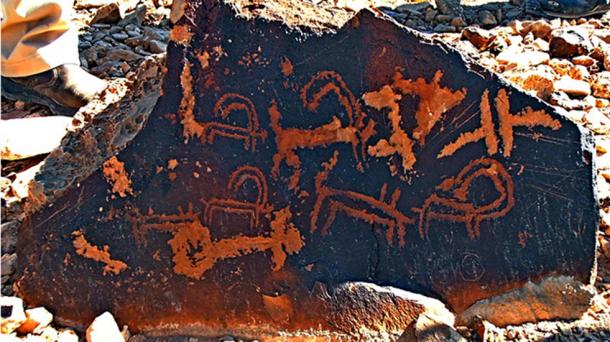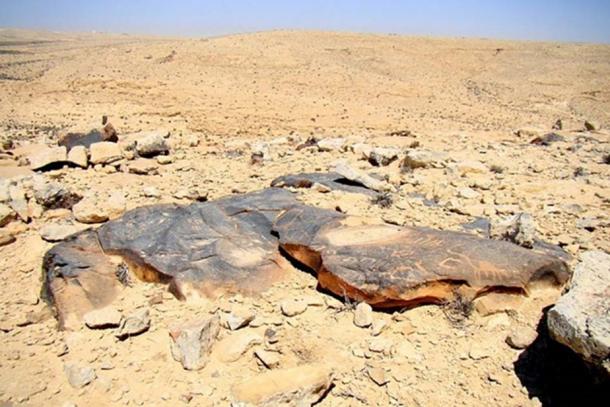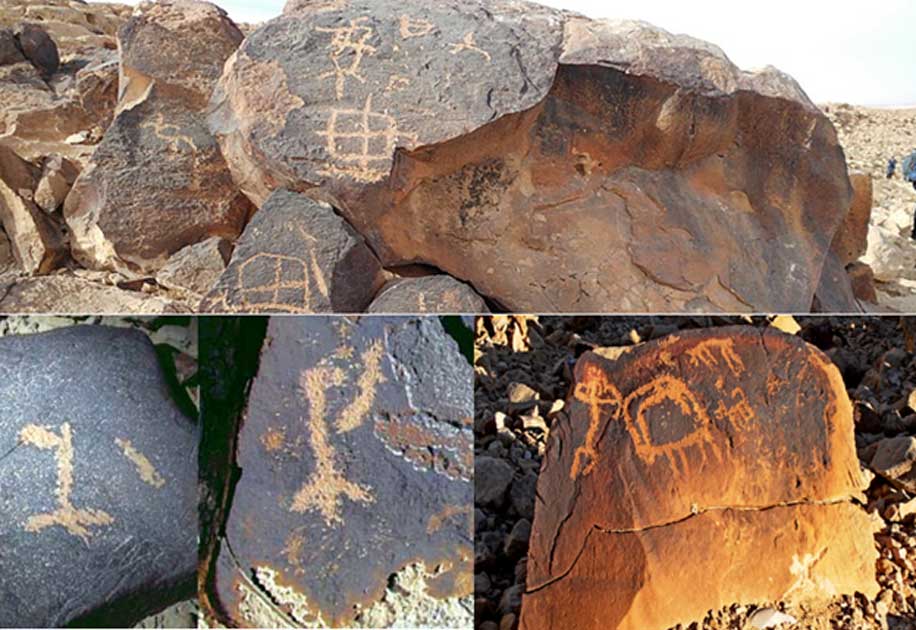Does the Negev’s Ancient Rock-Art Help Turn the Bible Exodus Story into Fact?
A chain of holy mountains with “god’s name” painted in ancient rock-art has led a scholar to claim he has finally identified the long sought after “lost region" inhabited by the proto-Israelies after the Exodus from Egypt.
The Bible details the lives of the Hebrew people and although their destiny after Egypt is hotly debated, their origins are equally mysterious. However, if the recent observations of author Yehuda Rotblum, as presented in his new book Rock Art in Israel, are right, then we all have to accept that "the greatest story ever told” actually happened. And proving that, would cause the mass regurgitation of Atheist’s breakfasts the world over.
Up to now, thousands of archaeologists outright deny the existence of any archaeology that supports the Old Testament story that around “three million Hebrews left Egypt” and lived as refugees in a desert. And, skeptics rest assured in the “inconclusiveness” about the actual location of Mt. Sinai. It should be considered, however, that this “absence of evidence” is brought into question by several professors, Dr. David Elton Graves for example, in his excellently researched book Biblical Archaeology, which presents hundreds of cases in which archaeology does indeed appear to support the words of the Bible.
Rotblum’s new findings were based upon a knowledge that with the rise of the Israelites came the “emergence of monotheism” the belief in one god. Coupling this fact with the Biblical reference: “the nation of Israel crystallized, during the 40 years of wandering, in the Negev Desert,” scholar Rotblum has published evidence suggesting the nation of Israel originated in the “Negev Desert and not in Egypt!”
- Similar Petroglyphs in Israel, America Reveal Ancient Global Language?
- Oldest Recorded Solar Eclipse Helps Date the Egyptian Pharaohs
- This 2,800-Year-Old Stele Tells A Bible Story From A Different Point Of View

Petroglyphs of Ibexes and symbols, Mount Karkom, Negev, Israel. (CC BY-SA 3.0)
Egyptian documents provided Rotblum with “a clue” that the Negev Desert dwellers “were perhaps the early Israelites,” according to his website which summarizes his findings. Rotblum then discovered rock art which “mentions the Shasu, ancient tribes that roamed the Sinai desert, the Negev Desert, and Transjordan.” The ancient Egyptian term “Shasu-Yahu” meant “The land of looters and their God is Yahu,” and Rotblum claims that the dwelling place of the god of the Shasu tribes is attributed to “several sites scattered throughout the wilderness of Paran, Edom, Midian, and Kushan.” He then made the assumption that “there was probably a union of several tribes all originating from the same father, Abraham, which is considered a great father in this region, even presently.”
Turning a Biblical key, Rotblum then considered the importance of “pilgrimage” to Hebrews, which is told in the Biblical passage “So now, let us go a three days’ journey in the wilderness to offer sacrifice to the LORD, our God.” (Exodus 3:18). Knowing each tribe had “its own holy mountain nearby” and that they were chosen to be about "three days walk,” Rotblum points out that “in the Negev Desert we have Mt. Arqub, Mt. Rahma, Mt. Mehia, Mt. Ardon, Mt. Ramon, Mt. Tzuriaz, Mt. Karkom, with “each probably a pilgrimage place.”
It can be argued that up to this point in Rotblum’s observations, everything, is entirely subjective, but his discovery of “unique rock art” in the Negev Desert depicting the Shasu’s name for God, that later became the God of Israel, seems to support his theory, and makes this all really quite interesting.

Petroglyphs in the Negev desert. (Igor Svobodin/Flickr)
The most prevalent word depicted on the rock art reads “YAH,” which is very similar to the name of the Shasu’s god, which was “YAHU.” Rotblum claims what “distinguished Israel from other emerging Iron Age neighboring cultures was the belief in Yahweh as the national god,” therefore the nomads who engraved god’s name on the rocks would appear to be “an important part of Israel’s past.” And tackling the problem of where Mount Sinai was actually situated, Rotblum claims “it is not ‘one’ mountain but several holy mountains scattered among the Midianite’s territory, each one designated by a different tribe as a dwelling place of their God Yahu.” This neatly explains the many conflicting references to Mount Sinai in the Bible and concluding, Rotblum stated “according to the Bible, the God of Israel always appears from the south direction, which is the Negev Desert.” And now, finding “god’s name” in rockart in the Negev desert has led him to the conclusion that this was the elusive, and legendary region, that the proto-Israelites inhabited after the Exodus from Egypt.
- Only 11 Tribes of Israel? Controversial Findings Reveal Danites Might Not Be Sons of Israel But Sons Of Greece
- Can the Bible, Bones and Bronze Age Jugs Finally Pinpoint the Tabernacle that Housed the Ark of the Covenant?
- New Analysis of Ancient DNA Proves that Canaanites Survived Biblical Massacre

Instances of names of god found in rock art of the Negev as sited by Yehuda Rotblum. (Image: © 2016 by Yehuda Rotblum)
Whether Rotblum’s theory sticks or not, only time will tell, but my prediction is that it will bomb. Why? Because in the face of amassing archaeological evidence which supports the claim that “ some” of the Biblical stories happened, there exists a hard line of skeptical, old school Atheistic archaeologists. Ironically, these professors commit exactly the same academic crime as they criticize “believers” for doing. They let their “personal beliefs” get in the way of hard evidence and choose to “let in” evidence which supports their cobweb strewn models of history.
This “old brigade” need to up their game and realize than in accepting that such events as the Exodus might actually have occurred, does not also prove that the Biblical God actually existed. It is in their deep-rooted fear of how their peers will perceive them, if they are seen as so much as entertaining such ideas, that my doubts for the longevity of Rotblum’s theory are founded, as accurate as it might be.
Top image: Top: A petroglyph portrays multiple symbols on Har Karkom ridge, Israel. (CC BY-SA 4.0). Bottom left: Instances of names of god found in rock art of the Negev as sited by Yehuda Rotblum. (Image: © 2016 by Yehuda Rotblum); Hunting an Ibex; Mount Karkom, Negev, Israel. (CC BY-SA 3.0)
By Ashley Cowie




















Comments
One piece of rock art does not prove anything. Let's not forget the obvious disdain the author has for atheists and the obvious pro bible bias. Also the fact that there is no mention of 3 million jews living in Egypt. When you have real proof it will be examined, until then it is just a piece of rock art.
I agree with Tsurugi! If the evidence is plausible then the possibility that these “ Negev Desert dwellers” were in fact the ancient Israelites shouldn’t be ignored by archeologists.
Couldn't agree more with the concluding paragraphs. Well said.